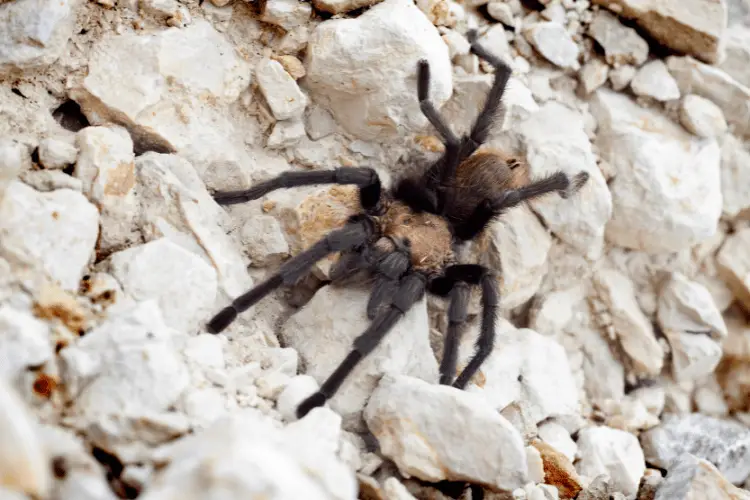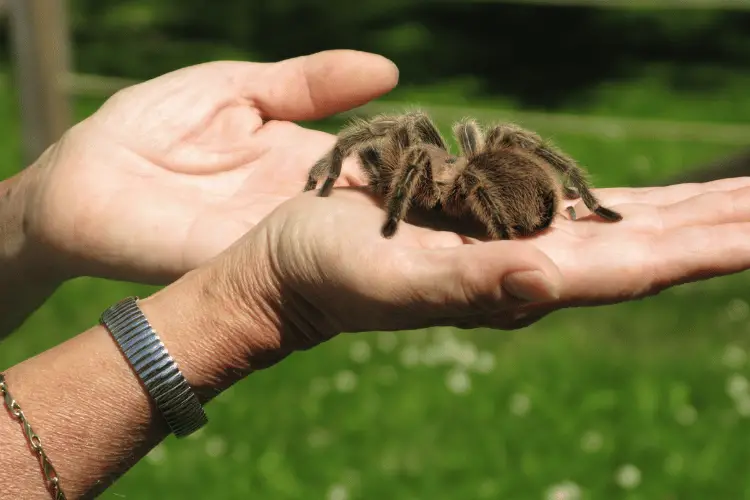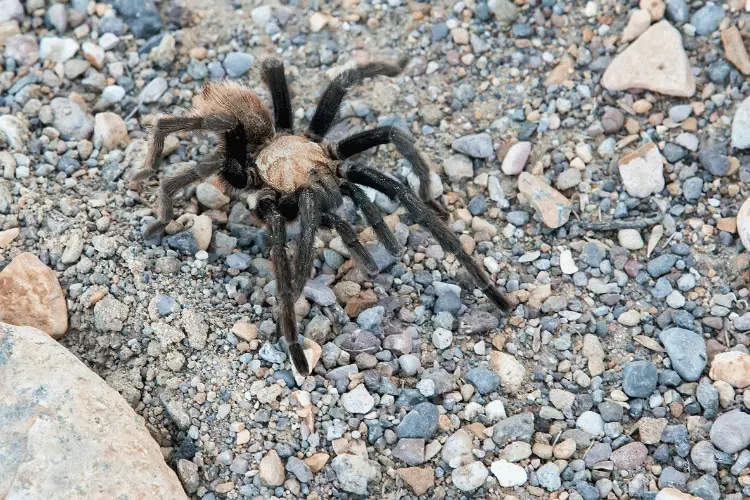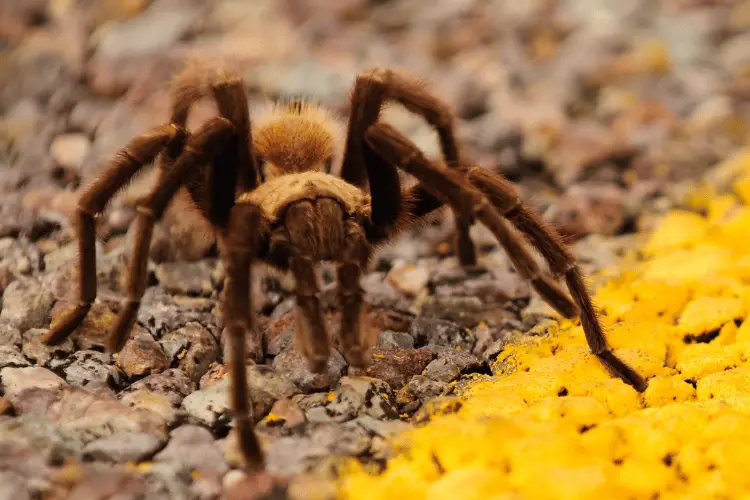We strive to provide you with authoritative, trustworthy, and expert advice. In doing so, the staff at texaswalkabout.com performs extensive research, editing, and fact checking to every post on this webiste. If you feel that this article can improve, please feel free to reach us at staff@texaswalkabout.com
We all have an image of what the classic hairy spider looks like. That seemingly scary vision is almost always the Texas brown tarantula.
Although their venom is quite mild, these spiders do have the typical terrifying appearance that terrifies many of us. What gives them that signature scary, fuzzy look is that their legs and bodies are covered in short brown hairs called setae.
However, putting your fears aside, up close they actually look like just any other cute furry pet. You quickly realize they’re not the deadly, spine-tingling predators we make them out to be.
Interested in finding out more about these tarantulas? Good, because in this post we rounded up as much info as we could find about these remarkable creatures.
Let’s get started.
Texas Brown Tarantula: An Overview
Texas brown tarantulas are known by many other names depending on which state they’re in. Besides Texas browns, the two most common names are Oklahoma browns and Missouri tarantulas.
Why?
Because these eight-legged creatures are more common in the grasslands and deserts of many southern states. Yet, they’re mainly found in abundance in Texas, Missouri, and Oklahoma, hence the names.
Texas browns can also be found in Arkansas, Colorado, Kansas, and Louisiana. They’ve also been spotted along the New Mexico and Texas borders where the climate is dry and arid.
This species has also been reported to live in the northern parts of Mexico.
Another surprising fact about these arachnids is that they’re not your typical web spinners. In other words, they don’t weave aerial webs in the hope that prey will stumble upon them and get trapped.
Instead, they’d rather stay hidden in their burrows and wait for their food to come to them. This habit of keeping to themselves is one reason why many consider them easy-going and docile.
In fact, many people actually keep them as pets because of their laid-back, agreeable demeanor. They’re also low-maintenance and easy to care for.

Physical Characteristics
Out of the more than 800 known species of tarantulas worldwide, 30 of them are in the United States and nearly half of those are in Texas alone.
Yet, out of the 14 different species in The Lone Star State, the most common is the Texas brown tarantula (Aphonopelma hentzi).
It’s also the largest. The legs of a fully grown adult can grow to an average span of between five and six inches and weigh around three ounces.
True to their name, Texas browns are varying degrees of mahogany. They can range from a shade of rich, chocolatey brown to a darker shade of the body.
The fused head, or cephalothorax, tends to be a lighter hue that appears more orange-tinted in the light.
Texas browns have a stocky build with a slightly smaller cephalothorax. They’re also known for their bulging abdomen, or rear end, which is covered in orange-tinted short bristles known as urticating hairs.
Being arachnids, they belong to the class of joint-legged invertebrates known as arthropods, which are the largest phylum in the animal kingdom.
Besides spiders, arthropods include insects, lobsters, crabs, centipedes, millipedes, mites, and scorpions. Out of all those, only spiders, mites, and scorpions are arachnids.
As with all arachnids, Texas brown tarantulas have eight long legs that are typically a darker shade of brown than the rest of their bodies.
Each leg is made up of seven segments that help them leap, sprint, and run quickly in any direction. Much like the phalanges on our fingers, these segments provide the Texas browns with better flexibility and mobility.
They also have two short, arm-like appendages called pedipalps. They’re located at the front of their bodies and they use them to grasp onto various objects, mainly their prey.
On the front of their heads, they have eight eyes and a chelicera.
The chelicera is another name for the mouth. It’s lined with muscles that help keep its prey in place as the tarantula injects its venom via the two fangs on each side of the chelicera.
Once subdued, the venom also helps the tarantula swallow and digest its food.
Despite having all those eyes, they actually have poor vision. So, they tend to rely more on their sense of movement along with their bristly setae, aka the hairs covering their bodies, to feel their way around.
Habitat
Texas brown tarantulas are easy-going terrestrials with predictable behavior patterns, especially when it comes to their living conditions. Their natural habitat is usually open fields, grasslands, tilled farmland, and deserts.
While they can live in places that provide good hiding spots like leaf litter and wood piles, they prefer to live in burrows underground. It’s cooler and makes it easier to stay out of sight of predators.
They either dig these burrows themselves or take over ones that have been abandoned by other animals. Once they establish their home, they cover the entrance with a white silky web.
This keeps the spider protected from potential predators. The web also acts as an alarm that helps the tarantula detect movement if there’s an approaching threat.
The only time you’ll see more of these arachnids out and about is when they’re looking for food and during their mating season.

These spiders also typically molt in the late summer or early fall once a year. As they age, they might mold only once every couple of years.
When molting, they wriggle out of their exoskeleton, which is their outer layer of skin, to make room for their growing bodies.
They’re more shy than normal during this time, wishing to hide away in their burrows. Because the molting process can be a stressful time, they tend to lose their appetite.
Yet, once it’s over, their appetite returns and they eat voraciously. Their colors are also much more distinct than before.
Feeding Habits
Consequently, these spiders prefer to come out at night or early morning to look for food when the temperatures are cooler.
Yet, they usually don’t tire themselves out with too much hunting. One reason is that they don’t eat that often. In fact, these brown arachnids can go weeks without any food at all.
This is another reason why they prefer that their food come to them. So, they usually stay near their burrows, hidden away until they spot something tasty.
If a prey happens to wander by, the tarantula will snag it up with its front pedipalps and then immediately encase it in a web.
Sometimes, it’ll also use its two fangs to inject venom into its prey. The venom paralyzes and subdues its mark.
It also contains digestive juices that help liquefy the prey. This makes it easier for the spider to swallow and digest it,
Texas brown tarantulas typically feed on small insects like roaches, beetles, grasshoppers, cicadas, caterpillars, and crickets. Yet, they’ve also been known to eat mice and small lizards.
Mating Rituals and Lifespan
The only time you can see them wander away from their burrows in large numbers is in the summer, particularly from May to July, during their mating season. This is the time when all tarantula species pop out of their underground holes to find a mate.
The male can travel as far as a hundred feet to several miles in any direction in search of a female.
Using the chemoreceptors on their feet, a male Texas brown can sense where the females are. Once he finds one, he heads to the opening of her burrow and gives a couple of knocks by tapping the ground with his legs. If the female is ready to mate, she’ll come out.
Next, the male spins a web, where he deposits his sperm. Then, he uses his front appendages, or pedipalps, to insert it into the female.
After mating, the male doesn’t return to its burrow. In a typical year, it can cohabitate with several females during one mating season.
Once that’s done, the male will likely die of exposure to cold weather or starvation. In rare cases, the female will mistake it for prey and eat it.
This is one reason why the lifespan of males is much shorter than that of females. While males live up to only 8–10 years, females can live for up to 30 years or more.
As for the females, they tend to hunker down for the winter and go through a period similar to hibernation. Their gestation period usually lasts for a couple of months.
Then, when springtime rolls around, they begin to lay their egg sack. After that, the eggs will take several months to hatch.

Females can lay around 1000 eggs at a time. Yet, not all survive, and out of those that hatch, not all of her spiderlings will live to become adults.
Predators
The most common predator of the Texas brown tarantula is the tarantula hawk, which isn’t a hawk at all, but really a type of viscous wasp.
This predatory winged insect relies almost entirely on the brown tarantula for breeding.
As with many other insects, the bright-colored tarantula hawk pollinates during the day. Yet, come nighttime, they fly in search of a Texas brown.
When they find one, they sting, which only paralyzes it but doesn’t kill it. Once sedated, the wasp carries the tarantula off to a secluded hole and lays its eggs on it.
When the eggs hatch, the larvae feed on the spider until they find their way out.
Other predators of the Texas brown include:
- Coyotes
- Exposure to the elements
- Fire
- Getting run over on desert highways and open roads
- Lizards
- Snakes
- Birds
- Foxes
Defense Mechanisms
This species of tarantula isn’t usually one to go looking for trouble. Yet, if provoked, they’ll certainly defend themselves.
So, even though they prefer not to venture too far away from the safety of their burrows, they’ll scuttle quickly to attack.
Having eight legs allows them to move extremely fast, but only over short distances. Otherwise, they tire out.
They can also leap about a couple of inches. It may not be that much compared to other types of tarantulas, but it’s still pretty impressive considering they’re only about 3–4 inches in length themselves.
We mentioned above that the venom on these arachnids isn’t particularly dangerous to humans. Their bite will look and feel more like a bee sting than anything else.
It’ll only leave a slightly red mark, maybe some swelling before it goes away on its own after a few days.
Yet, in the case of the Texas brown, it’s not the venom that worries people, but their urticating hairs. Urticating hairs aren’t really ‘hairs’ per se, but actually short, prickly bristles with barbs at their tips.
Located on the tarantula’s abdomen, the arachnid will kick its abdomen to fight its attacker or ward off a potential predator. This causes the barbs on the prickly bristles to work their way into the attacker’s skin.
Sometimes, if they’re close enough, they can simply flick off their urticating hairs at the predator. The barbs will help ensure they find their way into the skin and stay there.
Contact with urticating hairs can cause an inflammatory reaction, which includes itching, redness, and swelling that can last for weeks.
If disturbed, the tarantulas are known to sometimes turn around to face the threat. Then, they raise themselves up on their hind legs and stretch out their front legs and pedipalps in a sort of defensive stance.
Summing Up
The Texas brown tarantula goes by several names, depending on the region it inhabits. However, no matter where it resides, its behavior is almost always the same.
They‘re venomous, but only mildly so. Animal experts often compare a brown tarantula bite to a bee sting, which means they don’t pose a serious health risk.
This could be one reason why some people keep Texas brown tarantulas as pets. Though not the most common type of pet tarantula, they still make rather good companions because they’re low-maintenance.
Unfortunately, its hairy body and beady eyes make the Texas browns appear much scarier than they actually are. The truth is they’re actually pretty easy-going and generally non-threatening than many other wildlife creatures out there.

Robert is a native Texan writer for TexasWalkabout, passionate about Texas culture and food, wearing cowboy boots daily. He interviews local pitmasters and chefs, tastes and reviews innovative dishes, and explores hidden gems and iconic landmarks. Graduating magna cum laude in Cyber Security from the University of Texas at San Antonio, Robert excels academically and professionally while also being knowledgeable in Texas history and culture. After living in Texas for over 28 years, he provides first-hand and trustworthy information for all your Texas needs!

